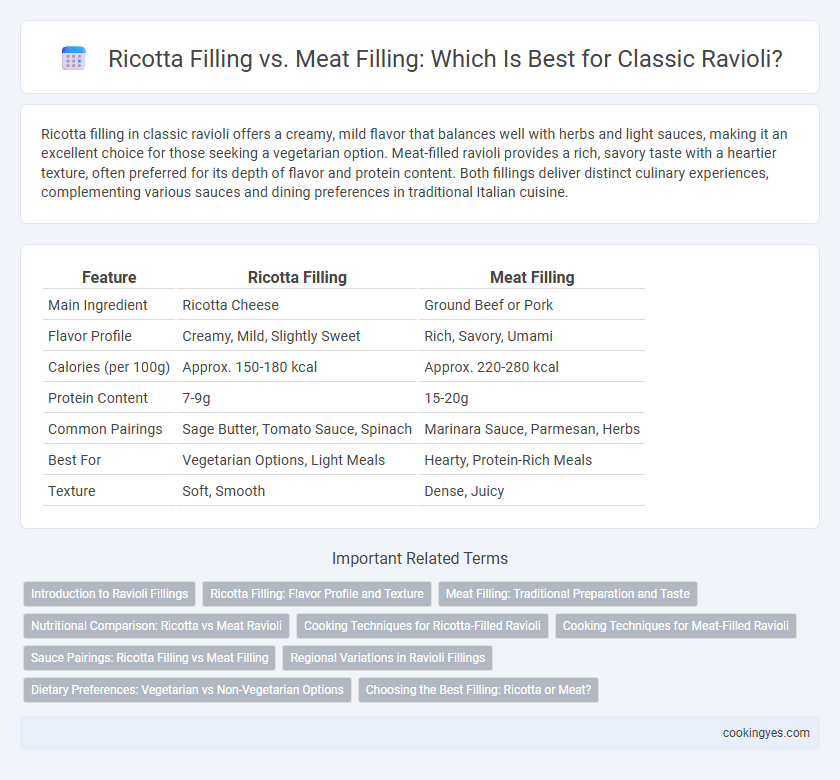Ricotta filling in classic ravioli offers a creamy, mild flavor that balances well with herbs and light sauces, making it an excellent choice for those seeking a vegetarian option. Meat-filled ravioli provides a rich, savory taste with a heartier texture, often preferred for its depth of flavor and protein content. Both fillings deliver distinct culinary experiences, complementing various sauces and dining preferences in traditional Italian cuisine.
Table of Comparison
| Feature | Ricotta Filling | Meat Filling |
|---|---|---|
| Main Ingredient | Ricotta Cheese | Ground Beef or Pork |
| Flavor Profile | Creamy, Mild, Slightly Sweet | Rich, Savory, Umami |
| Calories (per 100g) | Approx. 150-180 kcal | Approx. 220-280 kcal |
| Protein Content | 7-9g | 15-20g |
| Common Pairings | Sage Butter, Tomato Sauce, Spinach | Marinara Sauce, Parmesan, Herbs |
| Best For | Vegetarian Options, Light Meals | Hearty, Protein-Rich Meals |
| Texture | Soft, Smooth | Dense, Juicy |
Introduction to Ravioli Fillings
Ricotta filling in classic ravioli offers a creamy texture and mild flavor, often combined with herbs like spinach or nutmeg to enhance richness. Meat filling, typically made from ground beef, pork, or veal, provides a hearty and savory profile that complements robust tomato or brown butter sauces. Both fillings reflect regional Italian traditions and cater to varied taste preferences, creating distinctive ravioli experiences.
Ricotta Filling: Flavor Profile and Texture
Ricotta filling in classic ravioli offers a creamy, mild flavor with a slightly sweet and tangy undertone that complements the pasta without overpowering it. This filling provides a smooth, velvety texture that contrasts with the tender but firm pasta, creating a delicate mouthfeel. Unlike meat fillings, ricotta enhances the ravioli's lightness and pairs well with a variety of sauces, particularly tomato-based or butter and sage.
Meat Filling: Traditional Preparation and Taste
Meat filling in classic ravioli typically consists of a blend of ground beef, pork, or veal combined with Parmesan cheese, parsley, garlic, and nutmeg, creating a rich and savory flavor profile. This traditional preparation offers a hearty texture that contrasts with the smooth, creamy essence of ricotta fillings. Culinary experts often prefer meat-filled ravioli for its robust taste and satisfying mouthfeel, making it a staple in Italian cuisine.
Nutritional Comparison: Ricotta vs Meat Ravioli
Ricotta-filled ravioli typically offers lower calories and fat content while providing a good source of protein and calcium, making it a lighter option suitable for those seeking dairy-based nutrition. Meat-filled ravioli usually contains higher levels of protein, iron, and B vitamins but also comes with increased saturated fat and calorie counts, catering to individuals requiring more robust, energy-dense meals. Both fillings contribute essential nutrients, but ricotta excels in calcium and lower fat, whereas meat fillings provide richer protein and micronutrients like zinc and vitamin B12.
Cooking Techniques for Ricotta-Filled Ravioli
Ricotta-filled ravioli require gentle cooking techniques to preserve the delicate texture of the cheese, typically involving boiling in salted water for 2-4 minutes until the pasta is al dente. Unlike meat-filled ravioli, which often benefit from longer cooking to ensure doneness, ricotta fillings remain soft and creamy, demanding careful handling to prevent the ravioli from bursting. Steaming or sauteing after boiling can enhance flavor and texture for ricotta-filled ravioli without compromising the integrity of the filling.
Cooking Techniques for Meat-Filled Ravioli
Cooking meat-filled ravioli requires precise temperature control to ensure the filling reaches a safe internal temperature of 160degF (71degC) while maintaining tender pasta. Gentle simmering in water rather than boiling prevents the delicate dough from rupturing and releasing flavorful juices. Pan-searing after boiling creates a crispy exterior, enhancing texture contrast and intensifying the savory meat filling.
Sauce Pairings: Ricotta Filling vs Meat Filling
Ricotta-filled ravioli pairs exquisitely with light, creamy sauces such as bechamel or sage butter, enhancing the mild, creamy texture without overpowering it. Meat-filled ravioli, rich and robust, complements hearty tomato-based sauces like marinara or Bolognese, which add depth and balance to the savory filling. Both fillings benefit from complementary herbs; ricotta pairs well with basil and nutmeg, while meat filling shines with garlic and rosemary-infused sauces.
Regional Variations in Ravioli Fillings
Ricotta filling, prevalent in Northern Italian regions like Emilia-Romagna, offers a creamy and mild flavor profile that highlights local dairy traditions, while meat filling, common in Southern Italy and Tuscany, typically incorporates rich beef or pork blends that provide a heartier taste. The choice between ricotta and meat fillings reflects regional agricultural practices and culinary heritage, influencing the texture and seasoning of classic ravioli dishes. Local variations such as the ricotta and spinach combination in Liguria contrast with the spiced meat-filled ravioli from Naples, showcasing Italy's diverse ravioli filling spectrum.
Dietary Preferences: Vegetarian vs Non-Vegetarian Options
Ricotta filling in classic ravioli offers a creamy, mild flavor and caters to vegetarian dietary preferences by excluding meat, making it suitable for lacto-vegetarians. Meat filling, often made with ground beef, pork, or veal, provides a rich, savory taste and is preferred by non-vegetarian consumers seeking higher protein content. Choosing between ricotta and meat fillings allows for accommodating varied dietary needs while maintaining traditional Italian ravioli textures and flavors.
Choosing the Best Filling: Ricotta or Meat?
Ricotta filling offers a creamy, mild flavor complementing delicate pasta, ideal for those seeking a lighter, vegetarian option rich in protein and calcium. Meat filling, typically made from ground beef, pork, or veal, provides a hearty, savory taste that adds depth and richness, favored in traditional Italian recipes for its robust texture and flavor. Selecting the best filling depends on dietary preferences, desired taste profile, and the type of sauce paired, with ricotta excelling in subtlety and meat delivering a more substantial culinary experience.
Ricotta filling vs Meat filling for classic ravioli Infographic

 cookingyes.com
cookingyes.com